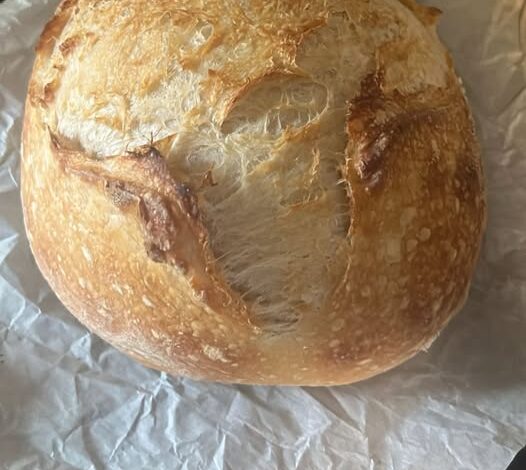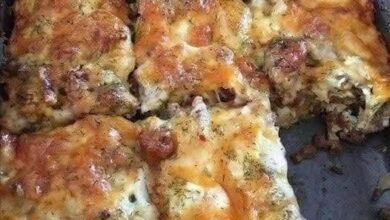Sourdough Plain Bread Recipe

There’s something deeply satisfying about baking your own sourdough bread. The process may take time, but the reward is a loaf with a crisp crust, chewy crumb, and rich, tangy flavor. Whether you’re a first-time baker or an experienced enthusiast, this sourdough plain bread recipe is a great way to explore the art of traditional bread-making.
What makes sourdough special is its natural fermentation. Instead of using commercial yeast, sourdough relies on a live fermented culture — the sourdough starter — which helps the dough rise and adds complex flavor. This method not only enhances taste but can also improve digestibility.
This recipe keeps things simple and wholesome. No fancy ingredients, just flour, water, salt, and your trusty starter. It’s a perfect base bread that you can enjoy as-is or customize with seeds, herbs, or other additions once you’ve mastered the basics.
🕒 Cooking Time and Serving
-
Prep Time: 25 minutes (active), plus 10-12 hours fermentation/proofing
-
Cook Time: 45-50 minutes
-
Total Time: Approximately 12-14 hours (mostly hands-off)
-
Servings: Makes 1 large loaf (8–10 slices)
🥖 Ingredients
-
500g (4 cups) bread flour (or all-purpose flour)
-
375g (1½ cups + 1 tbsp) water (room temperature)
-
100g (about ½ cup) active sourdough starter (fed and bubbly)
-
10g (2 tsp) fine sea salt
Optional for topping: flour for dusting before baking.
👨🍳 How to Make Sourdough Plain Bread
Step 1: Mix the Dough
-
In a large bowl, mix the flour and water until no dry bits remain. Cover and let rest (autolyse) for 1 hour.
-
After resting, add the sourdough starter and salt. Mix thoroughly using your hands until fully combined.
Step 2: Bulk Fermentation (First Rise)
-
Cover the dough and let it ferment at room temperature for 4–5 hours.
-
During this time, perform 4 sets of stretch and folds every 30 minutes to build strength in the dough.
Step 3: Shape the Dough
-
Turn the dough out onto a lightly floured surface. Pre-shape it gently into a round or oval.
-
Let rest for 20 minutes uncovered, then shape again and place into a lightly floured banneton (proofing basket) or a bowl lined with a floured towel.
Step 4: Final Proof
-
Cover and place in the fridge overnight (8–12 hours) for a slow, cold proof.
Step 5: Bake the Bread
-
Preheat your oven to 230°C (450°F) with a Dutch oven inside for at least 30 minutes.
-
Carefully transfer the dough onto parchment paper, score the top with a sharp blade, and place it into the hot Dutch oven.
-
Bake covered for 20 minutes, then uncover and bake for another 25–30 minutes until golden and crisp.
Step 6: Cool
-
Let the bread cool completely on a wire rack before slicing.
📝 Notes
-
Your sourdough starter should be active and bubbly when used — feed it 4–6 hours before baking.
-
You can adjust hydration based on your flour; some flours absorb more water.
-
Scoring the dough helps control the rise and gives that signature artisan look.
-
No Dutch oven? Bake on a preheated baking stone with a pan of hot water for steam.
❓ FAQs
Q: Can I use whole wheat flour instead of white flour?
A: Yes, but it will change the texture and flavor. Start by substituting 20–30% with whole wheat.
Q: My dough is too sticky — is that normal?
A: Yes, sourdough dough is usually sticky. Wet your hands when handling it, and don’t over-flour.
Q: How do I store the bread?
A: Keep it at room temperature in a bread bag or wrapped in a cloth for up to 3 days. For longer storage, slice and freeze.
Q: What if I don’t have a sourdough starter?
A: You’ll need to create one, which takes about 5–7 days. You can also use instant yeast for a quicker version, though it won’t have the same flavor.
🍽️ Nutrition Information (Approximate, per slice — 1 of 10 slices)
| Nutrient | Per Serving (1 slice) |
|---|---|
| Calories | 165 kcal |
| Carbohydrates | 34 g |
| Protein | 5 g |
| Fat | 0.5 g |
| Fiber | 1.5 g |
| Sodium | 200 mg |
| Sugars | 0 g |
Note: Values vary slightly depending on flour brand and hydration level.
⚠️ Disclaimer
This recipe is intended for general enjoyment and should be consumed in moderation. Individuals with gluten intolerance, wheat allergies, or sourdough sensitivity should consult a healthcare provider before consuming. Always check ingredient labels if you have specific dietary restrictions or allergies.




